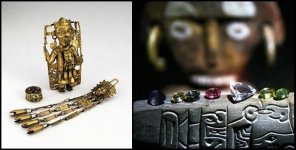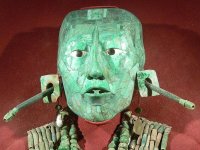- Feb 2, 2013
- 1,426
- 1,992
- Detector(s) used
- Many
- Primary Interest:
- All Treasure Hunting
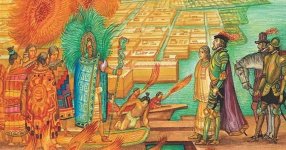
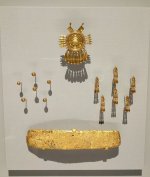
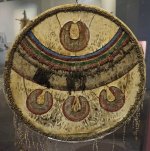
MOCTEZUMA II TREASURE MYSTERY
This is a matter that has been unresolved for the last 500 years. The more time goes by the only thing that gets rich is the great legend of the hidden treasures of Aztec royalty. But also, there are some findings that test the myth.
The first to see the treasure of Moctezuma II were Hernán Cortes and his men. Upon arrival in Tenochtitlán, the warriors were hosted at the Axayácatl Palace (now the Mount of Piedad of the Historic Center), the house where the emperor's father lived.
Upon arriving there, the guests were dedicated to hunting for treasures. They had heard rumors and when their hosts left them alone they took the opportunity. Desperate, they snooped around the residence until they found a superimposed tapia they threw down and found a door:
′′(...) and when it was opened, Cortes with certain captains entered first inside, and saw so much number of gold jewelry and plates, and many knitting, and chalchihuites stones and other great riches; they were elevated ", Bernal Diaz narrates of the Castle in the True History of the Conquer of New Spain.
The young Bernal, who embarked on the adventure of his life, recounts: ′′ As at that time I was mancebo and had not seen riches like those in my life, I had by the way that there should not be so many in the world ".
Riches, according to Mexican tradition, could not be touched by Emperor Moctezuma II. Treasures could only be increased, just like their father and grandfather had.
The wealthy fortune was protected in the so-called Teucalco. When that was opened, the Spaniards found gold artifacts such as earrings, headbands, pen tissues, fine shields, nose lunettes, ajorcas, necklaces, figurines, rings, bands, buttons and jewelry.
All the gold the conquerors found was melted and turned into bars. To their allies, the Tlaxcaltecas, they only gave them chalchihuites, jade stones, feathers and fine wood.
If anyone suffered for the treasures of the empire it was Cuauhtémoc. The emperor who fiercely fought foreigners decided to get rid of treasure days before the city fell.
After his capture, Cortes and his men tortured him to relate where the treasures were. But despite the escarmiento, there was nothing left in the emperor's coffers; the most they managed to get, after burning his feet with fire and burning him with boiling oil, was the confession that he had thrown everything into the lagoon.
The ambition of conquerors made them dive into the water in search of gold pieces, Cortes called the best swimmers in the troop and they managed to get out a portion of the treasure.
The informants later recounted to the friar Bernardino de Sahagún: ′′ How true is that (gold) that the Spaniards crave with great thirst, they widen their bodies for that reason, they are hungry furious for it. Like hungry pigs crave gold ".
Nothing was heard from that gold for centuries. Although many rumors claimed that part of the imperial treasures were thrown into the lagoon that is in the snowy Toluca, it was also suggested that they were under the lozas of some churches in Mexico City; the reasoning was that many of these were raised over Aztec ritual centers, where silver and gold were offered to the gods.
But if anyone has been close to enjoying the treasures of Moctezuma II, it is the humble Veracruzan fisherman Raúl Hurtado, who one morning went out, as usual, to fish octopuses in Punta Gorda, Veracruz, but what he found was a golden chest with embedded pectoral and jade.
The year of 1976. was running. The humble fisherman had found a source of riches guarded by octopuses. Most likely some Spanish galleon would have gone aground and sunk in that lonely sea frequented by pangas of fishermen.
Hurtado started fishing for treasures, in its secret place in front of the reefs of La Blanquilla. For days, he spent days frequenting his small source of treasures and with the complicity of a jeweler melted the pieces to exchange them for weights.
But someone discovered his secret, as man's small fortune grew beyond what octopuses allow.
Hurtado was arrested and beaten by police, and jailed for ′′ stealing the nation ".
Time later, the octopus fisherman helped archaeologists find more treasures on the reef. Part of these are shown at the Santiago Baluarte del Puerto de Veracruz.
On March 13, 1981, another man took a stroke of luck: Francisco Bautista found the ′′ Golden Tejo de la Alameda ", a gold bar of about two kilograms, 5 meters underground I love you so much The site of the finding is located on the side of the Alameda of Mexico City, where the offices of the Tax Administration System are now located.
The National Institute of Anthropology and History has just announced, thanks to fluorescent X-ray studies, that this piece of gold was melted between 1519 and 1520. Right in the years when Cortes and his men dedicated to melting the Imperial jewelry.
SOURCE:
https://piedepagina.mx/el-lugar-donde-se-encuentra-el-tesoro-de-moctezuma-ii/



